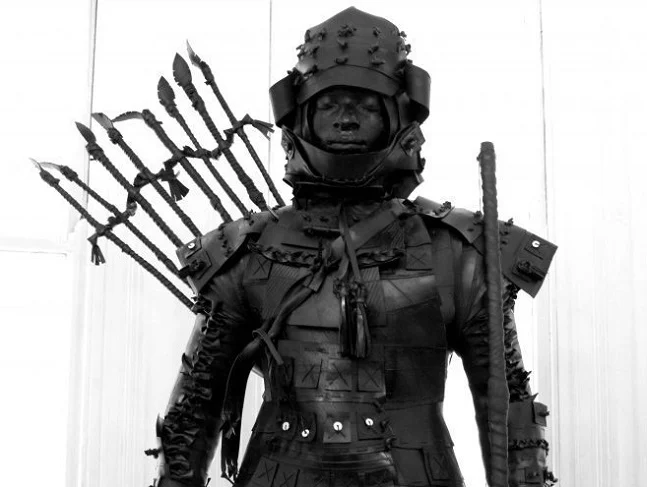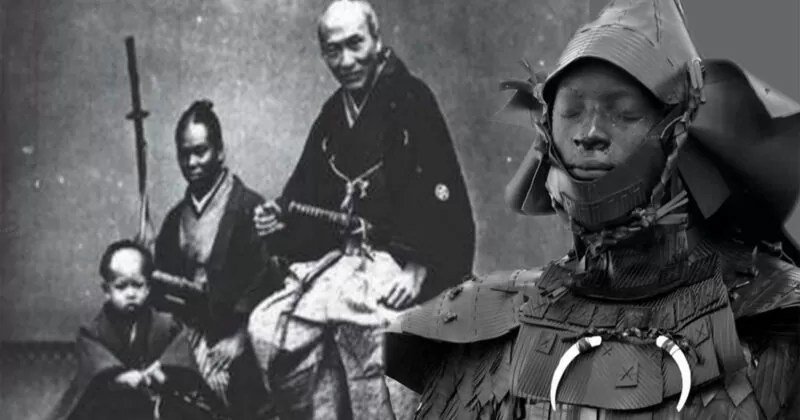
 Yasuke (弥助 or 弥介) was a man of African origin who served as a retainer and weapon-bearer[1][2][3] to the Japanese daimyō Oda Nobunaga.[4] In 1579, Yasuke arrived in Japan in the service of the Italian Jesuit missionary Alessandro Valignano, Visitor of Missions in the Indies, in India. Yasuke was one of the several Africans to have come with the Portuguese to Japan during the Nanban trade and is thought by some to have been the first African that Nobunaga had ever seen.[5][6] He was also present during the Honnō-ji Incident, the forced suicide of Nobunaga at the hands of his general Akechi Mitsuhide on 21 June 1582.[7]
Yasuke (弥助 or 弥介) was a man of African origin who served as a retainer and weapon-bearer[1][2][3] to the Japanese daimyō Oda Nobunaga.[4] In 1579, Yasuke arrived in Japan in the service of the Italian Jesuit missionary Alessandro Valignano, Visitor of Missions in the Indies, in India. Yasuke was one of the several Africans to have come with the Portuguese to Japan during the Nanban trade and is thought by some to have been the first African that Nobunaga had ever seen.[5][6] He was also present during the Honnō-ji Incident, the forced suicide of Nobunaga at the hands of his general Akechi Mitsuhide on 21 June 1582.[7]
Early life
According to Histoire ecclésiastique des isles et royaumes du Japon, written by Jesuit priest François Solier of the Society of Jesus in 1627, Yasuke was likely from Mozambique.[1][8] This would be consistent with other accounts of Africans from Mozambique in Japan. According to Fujita Midori, the first African people who came to Japan were Mozambican. They reached Japan in 1546 as shipmates or slaves who served Portuguese captain Jorge Álvares (not to be confused with another explorer of the same name who died in 1521).[9]
In 2013, a Japanese TBS television program titled Sekai Fushigi Hakken! (世界ふしぎ発見!, “Discovery of the World’s Mysteries!”) suggested that Yasuke was a Makua named Yasufe.[10] This name seems to be derived from the more popular Mozambican name Issufo.[11] However, the program provided little evidence for its conclusions. The Makua are not documented as having had any significant contact with the Portuguese based in Mozambique until 1585.[12]
Yasuke may have been a member of the Yao people,[13] or from the more inland area of Mozambique.[14] Yao people were just coming into contact with the Portuguese at the time, which might account for his name: that is, Yao added to the common Japanese male name suffix of suke produces Yao-suke.[13]
Yasuke may have been a slave. Thomas Lockley acknowledges it is possible that Yasuke was enslaved as a child and sent to India, where he could have been employed as a military slave or an indentured soldier, but that he likely obtained his freedom before meeting Valignano.[15][16] Valignano employed him as bodyguard and valet.

Sudanese claims
Another claim suggests that Yasuke was a Dinka from South Sudan. He was famous for his height and extremely dark skin color. The Dinka people are among the tallest in Africa, and have significantly darker skin compared to Ethiopians, Eritreans, or Somalis for example. Adult Dinka men had a ritual custom of drawing decorative patterns on their faces by tattooing, but no account of Yasuke having a face pattern was recorded.[17]
Ethiopian claims
According to another theory, Yasuke was from Ethiopia. Thomas Lockley suggested that this theory is most convincing. Like Yasuke, Ethiopians who were not Jewish (i.e. Beta Israel), Christian, or Muslim were often sold into slavery and called cafre by the Portuguese; they were well‐built and skilled soldiers.[18] According to this theory, his original name might be the Amharic name Yisake or the Portuguese name Isaque, derived from Isaac.[19] Yasufe was also used as a surname in Ethiopia.[20]
Documented life in Japan
Yasuke arrived in Japan in 1579 in service of the Italian Jesuit missionary Alessandro Valignano, who had been appointed the Visitor (inspector) of the Jesuit missions in the Indies (which at that time meant East Africa, South, Southeast, and East Asia). He accompanied Valignano when the latter came to the capital area in March 1581 and his appearance caused much interest with the local people.[21]
When Yasuke was presented to Oda Nobunaga, the Japanese daimyō thought that his skin must have been colored with black ink. Nobunaga had him strip from the waist up and made him scrub his skin.[22] These events are recorded in a 1581 letter of the Jesuit Luís Fróis to Lourenço Mexia, and in the 1582 Annual Report of the Jesuit Mission in Japan, also by Fróis. These were published in Cartas que os padres e irmãos da Companhia de Jesus escreverão dos reynos de Japão e China II (1598), normally known simply as Cartas.[23][24] When Nobunaga realized that the African’s skin was indeed black, he took an interest in him.
The Lord Nobunaga Chronicle (信長公記, Shinchō Kōki) corroborates Fróis’s account.[25] It describes the meeting thus: “On the 23rd of the 2nd month [23 March 1581], a black page (黒坊主, kuro-bōzu) came from the Christian countries. The man was described as robust, black as a bull, and of fine character.[25] Nobunaga’s nephew gave him a sum of money at this first meeting.”[26] On 14 May, Yasuke departed for Echizen Province with Fróis and the other Christians. During this trip, they met local warlords such as Shibata Katsutoyo, Hashiba Hidekatsu, and Shibata Katsuie.[27] They returned to Kyoto on 30 May.[28]
It is likely that Yasuke could speak or was taught Japanese, perhaps due to Valignano’s efforts to ensure his missionaries adapted well to the local culture.[29] Nobunaga enjoyed talking with him (there is no indication that Nobunaga spoke Portuguese, and it is unlikely that Yasuke would have been able to communicate in classical Chinese, the East Asian lingua franca of the time). He was perhaps the only non-Japanese retainer that Nobunaga had in his service, which could explain Nobunaga’s interest in him.[29] Yasuke was mentioned in a variant text of the Shinchō-ki (信長記) owned by Sonkeikaku Bunko (尊経閣文庫), the archives of the Maeda clan.[30] According to this, the black man named Yasuke (弥助) was given his own residence and a short, ceremonial katana[dubious – discuss] by Nobunaga. Nobunaga also assigned him the duty of weapon bearer.[31][failed verification]
After the Battle of Tenmokuzan, Nobunaga led his force, including Yasuke, and inspected the former territory of the Takeda clan. On his way back, he met Tokugawa Ieyasu. Matsudaira Ietada, the retainer of Ieyasu described Yasuke as “6 shaku 2 sun (6 ft. 2 in., or 188 cm.). He was black, and his skin was like charcoal.” Matsudaira stated that he was named Yasuke (弥介).[32]
In June 1582, Nobunaga was attacked and forced to commit seppuku in Honnō-ji in Kyoto by the army of Akechi Mitsuhide. Yasuke was there at the time and helped fight the Akechi forces. Immediately after Nobunaga’s death, Yasuke went to join Nobunaga’s heir Oda Nobutada, who was trying to rally the Oda forces at Nijō Castle. Yasuke fought alongside the Nobutada forces but was eventually captured. When Yasuke was presented to Akechi, the warlord allegedly said that the black man was an animal as well as not Japanese and should thus not be killed, but taken to the Christian church in Kyoto, the Nanbanji (南蛮寺).[22][3] However, there is some doubt regarding the credibility of this fate.[33][25] There is no further written information about him after this.
Citations
- “Yasuke: le premier samouraï étranger était africain”. Rfi.fr (in French). 2 January 2015. Archived from the original on 14 January 2020.
- Mohamud, Naima (14 October 2019). “The mysterious life of an African samurai”. BBC News. Archived from the original on 1 November 2020.
- Murakami, Naojiro; Yanagitani, Takeo (2002). イエズス会日本年報 上 [Society of Jesus – Japan Annual Report, First Volume]. New Foreign Country (in Japanese). Maruzen-Yushodo. ISBN 978-4-8419-1000-1.
- Matsudaira, Ietada (1968). Ietada Nikki. Kyoto: Rinsen Shoten. pp. 14–15. ISBN 978-4-04-703304-7.
- Cooper 1965, pp. 41–43
- Cooper 1965, p. 66
- Ōta, Gyūichi (2017). Shinchō Kōki. Tokyo: Chikuma Shobō. ISBN 978-4-480-09777-4.
- Histoire ecclésiastique des isles et royaumes du Japon [Ecclesiastical History of the Isles and Kingdoms of Japan] (in French). Vol. 1. p. 444. Archived from the original on 31 January 2017. Retrieved 22 June 2013.
- Fujita 2005, pp. 1–2.
- 信長最期の刻 — 本能寺にいた「漆黒のサムライ」を追え! (in Japanese). Archived from the original on 11 June 2013. Retrieved 6 September 2013.
- Lockley 2017, pp. 199–200
- Lockley 2017, pp. 180–181
- ^ Lockley 2017, pp. 200–202
- Lockley 2017, pp. 181–182
- “The True Story of Yasuke, the Legendary Black Samurai Behind Netflix’s New Anime Series”. Time. Retrieved 12 November 2021.
- Aga Khan Museum (18 February 2021), Lunchtime Lecture — Yasuke: An African Warrior in Japan with Prof. Thomas Lockley, retrieved 17 November 2021
- Lockley 2017, pp. 187–88.
- Lockley 2017, pp. 193–94.
- Lockley 2017, pp. 198–202.
- Lockley 2017, p. 200.
- Hollingworth, William (15 June 2019). “‘African Samurai’: The story of Yasuke – black samurai and warlord’s confidant”. The Japan Times. Retrieved 18 December 2019.
- Fujita 2005, pp. 8–9.
